History of Mughals
History of Mughals-
The History of Mughals is a very interesting and curious topic to be known because of its remarkable landmark in the history. It takes a huge space in the history of India, so here are some facts about the rise and fall of the Mughal Empire. The Mughals ruled northern India from 1526 to 1857 AD. The lodhis were the last dynasty in Delhi before the Mughals established their presence. In 1529, at Panipat a battle was fought between Babur and Lodhi army. Lodhi army was defeated.
Here's the list of Mughal rulers who plays an important role in the history of Mughal Empire-
Babur (1526 to 1530)-
Babur was the king of Kabul. Like his ancestor Timur, he also wanted to loot India. Being an able general, Babur could easily defeat the Lodhi soldiers. In the Battle of Panipat, Babur was helped by the Rajput Prince, Rana sanga of Mewar. After winning the battle, Babur not only took his share of the loot, but also established himself as the ruler. He defeated Rana sanga and the Afghan generals who helped in his battle against the Lodhis. Babur was a great scholar. He wrote down whatever he saw. These writings were called Babur Nama. He was an admirer of Nature's bounty. He built many parks inside and outside the palaces. Though he laid the foundations of Mughal rule in India, he did not live long to see it growing.
Humayun(1530-1540 and 1555-1556)-
After Babur his son Humayun became the ruler. The afghan Nobles wanted the Mughals to leave India. Sher Shah and Afghan, defeated Humayun in 1540. He escaped to Iran where he passed 12 years of his life. Humayun lost his power. After Sher Shah's death Humayun invaded India in 1555 and defeated his brothers and the Afghans. He once again became the ruler of India. Unfortunately he died in 1556 while climbing down the stairs of his library(Din panah) and was burried in Delhi. His sister, Gulbadan Begum, wrote his biography 'Humayunama'.
Sher Shah(1540-1545) -
In 1539, he defeated Humayun in the battle of chausa and assumed the title 'Sher Shah' as emperor. After defeating Humayun, Sher Shah became the ruler of India. He was an able administrator. He introduced a rational system of Taxation. He introduced many reforms. He constructed the Grand Trunk Road, he planted trees, built rest houses. He issued the coin known as Rupia, which we call today as Rupee. He introduced the principal of local responsibility for local crimes. Muqaddams were punished for failure to find culprits. He also introduced the postal system. As an emperor, he conquested Malwa, Ranthambor, Raisin, Rajputana-annexation of Marwar, Chittor and Kalinjar. He died in an accident in 1545 while conquesting Kalinjar. He was buried in Sasaram. In 1555, Humayun regained the throne.
Akbar the Great(1556-1605)-
Akbar was 13 when he became the ruler. His guardian Bairam Khan, a distinguished general became the Regent. When Akbar attained the age, he took over the government. Gwalior, Ajmer, Malwa and Jaunpur were won by Akbar. He was very friendly with the Hindus. Through matrimonial alliances and through appointment of Hindus in high positions, Akbar was able to command over a large empire. Akbar divided his empire into 15 provinces or Saba's. Each Sabha was subdivided into a number of sarkars and each sarkar into Parganas. The governor or Subadar was responsible for the law and order of his sabha. Akbar introduced a Mansabdari system by which every officer was given a rank or mansab. The officers and nobles were paid grants of land revenue known as Jagirs. The state enjoyed income from two sources land revenue and trade. Sea trade brought the Europeans to India. Though himself illiterate, Akbar encouraged scholars, Great scholars like Abul Fazi, Faizi, Birlbal and Todar Mall enjoyed Akbar's love and respect, Persian was the official language that time. Writing in Hindi made its beginning during Akbar's time. Akbar was a great patron of music and art. Tansen, the famous musician used to entertain the king. New Indo-Persian style of art and architecture developed. Akbar built magnificent palaces, gardens, learning centers etc. Fatehpur sikri is an example of the excellent style of architecture that was famous at that time. Akbar was liberal in his policy towards non-muslims. Infact he established a religion which was common to all, contained the common teachings of all religions. Akbar called it Din-i-ilahi or divine monotheism. It was worth mentioning here that the idea of sulh-i-kul or universal peace and harmony was the message of Din-i-ilahi. His court had the 'Nine gems'. One of the 'Gems' Abul Faizi wrote 'Akbar Nama'. Faizi translated Bhagavad Gita into Persian. Birbal's wit and intelligence was well-known. Akbar's sincere efforts to bring the Indians together were a landmark in the social life of the people. Akbar is considered the 'real founder of Mughal empire in India'. Akbar gave India one official language (Persian). When Akbar died, he was buried at Sikandara near Agra.
Jahangir(1605-1627)-
Jahangir succeeded Akbar. He was an admirer and follower of many of his father's qualities. Because of Akbar's efforts and far-sightedness, Jahangir could enjoy a peaceful reign. Rulers of Mewar and Ahmednagar became his allies. It is during this time that Sir Thomas Roe and Captain Hawkins visited India as an ambassador of the king of England. Jahangir's queen Mehrunisa whom he called Nur Jahan was very beautiful, intelligent and educated. She literally ruled over the kingdom. Jahangir issued coins jointly in name of Nurjahan's and his own. When Jahangir gave permission to the Britishers to set up factories in India, he had no idea that the Britishers would become the rulers. The memoirs of Jahangir is called Tuzuki-i-Jahangir. Ustad Mansur, a famous painter of animals and birds, found a good position in Jahangir. He was a lover of nature. He wrote his memoirs Tuzuk-i-Jahangiri in Persian. He died in 1627 and buried in Lahore.
Shah Jahan(1627-1659)-
Shah Jahan became a ruler after the death of Jahangir. He was known for his Deccan and foreign policies. Shah Jahan had to deal with many revolts. Shahjahan's reign is said to have marked the pinnacle of the Mughal dynasty. He is known for the promotion of art, culture and architecture during his time. Tajmahal, the world famous tomb of his queen Mumtaj mahal and the peacock throne belong to his reign. Diwan-i-Am, Diwan-i-Khas, the Jama Masjid, the Moti Masjid, the Red fort etc. are the monuments Shah Jahan built. The Taj Mahal on the banks of the river, Yamuna, a marvel of marbles, precious and semi-precious stones, gold and silver is one of the seven wonders of the world. It took 20 years to build the marble marvel. Shah Jahan in his old age had to witness the fight for the throne among his four sons. One of the sons, Aurangzeb defeated his brothers. Imprisoned his father and crowned himself as the king. In 1666 shah jahan died at the age of 74. He was buried at Taj(Agra).
Aurangzeb(1659-1707)-
Aurangzeb's reign of nearly 50 years was full of conflicts. During the first 23 years of the rule Aurangzeb concentrated on North India. During this period the Maratha's under Shivaji rose to power and were a force to reckon with. He raised the taxes to sustain the campaigns. By himself an honest man with a simple lifestyle, he was a musalman to the core. So his rule with the help of the laws of Islam made him very unpopular. The Rajputs, the Sikhs, the Jats, the Marathas resisted him. As if this is not enough, he had to face trouble with the Portuguese and the English. He destroyed many Hindu temples. He banished all scholars, artists and poets from his court. So when he died, in March 1707, the empire was collapsing. He was called Zinda Pir, the living saint. He was buried at Khudabed(Daulatabad).
Shivaji and the Marathas-
The death of Aurangzeb led to chaos and confusion about the succession to the throne. Bahadur Shah became the king but had to face the defiance of the Rajputs, the Sikhs, the Marathas and the Afghans. He died in 1712. The Marathas came to power. Foreign invasions of Nadir Shah and Ahamad Shah Abdali weakened the Mughal empire. Though the Marathas were defeated by the Afghans at the Battle of Panipat in 1761, they regained power. And the powerful Maratha leader was Shivaji. Shivaji was ambitious and decided to head an independent Kingdom. With a small army of brave soldiers, with intelligent planning and execution of strategies, Shivaji succeeded in overcoming enemies. He was an epitome of patriotism. History tells us that Shivaji was a real pain in the neck for Aurangzeb. A brave, fearless warrior, Shivaji is even now remembered as the most popular hero who dared against the Mughals.
The Final Fall-
After Aurangzeb's death, the Mughal empire broke down due to the internal quarrels among the nobles in the court, among sons of Aurangzeb, the attacks from outside and the inefficiency of the rulers. The Persian rulers Nadirshah attacked India and carried away huge quantities of gold, jewels and other treasures from India. He killed many and destroyed beautiful buildings in Delhi. He left India with the Koh-i-noor diamond, the Takht-i-Toos, elephants and horses. During the reign of Alamgir-2,the English East India Company defeated the Nawab of Bengal in the Battle of Plassey in 1757. During the time of Shah Alam-2, the third Battle of Panipat between the Marathas and the Afghans and the Battle of Buxar between the East India Company and the joint army of Mir Kasim, Suja-ud-Daula and Shah alam-2 happened. During the time of last Bahadur Shah Zafar, the revolt of 1857 broke out. The British suppressed the revolt, exiled the Emperor to Rangoon where he died in 1862. The Mughal Empire lasted for nearly 350 years. One of the reasons for its fall was that, down the line of success, it is met with financial troubles. The zamindars with the support of the peasants defied the Emperors. The aristocracy, steeped in luxury and enjoyment was completely unaware of the advent of the Europeans who were eagerly and cleverly looking for weak spots to expand their empire and treasury.
Mughal Architecture-
1. Babur built two mosques, one at Kabulibagh in panipat and the other at Sambhal in Rohilakhand.
2. Humayun's tomb was built by his widow Haji Begum.
3. Buland Darwaja, formed the main entrance to Fatehpur sikri.
4. Salim chisti's tomb is the first mughal building in pure marbal.
 |
5. The architecture of Fatehpur sikri is known as epic in red sand stone.
6. Jahangir built Moti Masjid in Lahore at his mausoleum at Sahadara.
7. Shahjahan also built the Jama Masjid.
8. He laid the foundation of Shahjahanabad in 1637 where he built the Red Fort and Takht-i-Taus(Peacock throne).
9. Only monument associated with Aurangzeb is Bibi ka Makbara, the tomb of his wife.
10. Aurangzeb also built the Badshahi Masjid in Lahore.
Mughal Miniature Paintings-
Humayun had taken into service two master painter Mir syed Ali and Abdus Samad.
Daswant and Basawan were two famous painter's of Akbar's court.
Abdul Hassan, Ustad Mansur and Bishandas were three famous painter's of Jahangir's court.
Mughal Garden-
These Gardens generally influenced by Persian Gardens. These Gardens built by Mughals is a unique and creative piece. These resembles with the Charbagh structure which represents the co-existence of humans with all elements of nature.
These are generally rectilinear layouts with walled enclosures. It generally contains pools, fountains, canals inside the gardens. We can see Mughal gardens generally in Afghanistan, Pakistan, Bangladesh and India.
Below are some of the pictures of these beautiful creation. Have a look.
















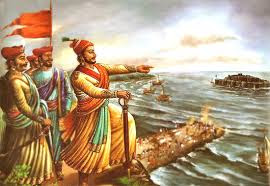
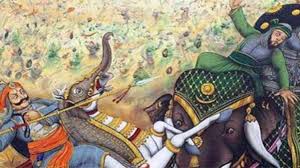








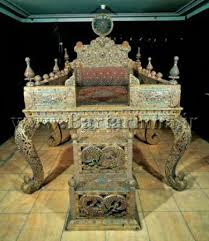









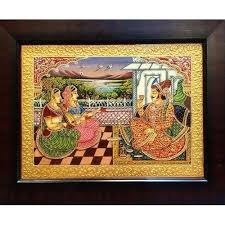

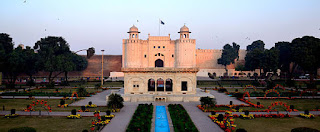








Comments
Post a Comment
If you have any doubts, please let me know